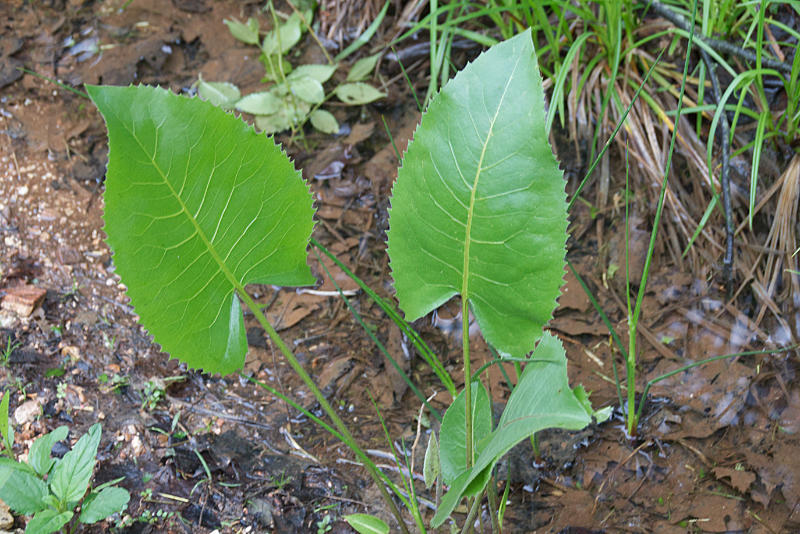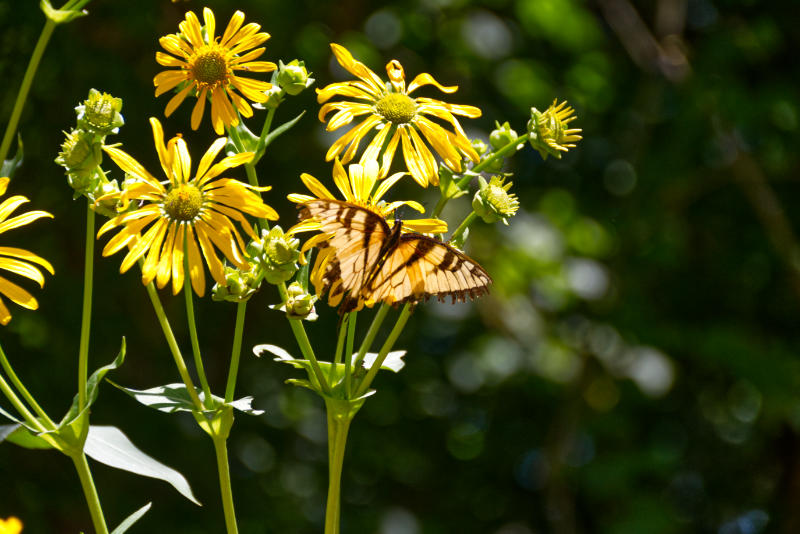
Welcome to the wonderful world of Prairie Dock! If you’re wondering what this plant is, don’t worry, you’re not alone. In short, this is a fascinating plant native to the prairies of North America that has a variety of unique and surprising features. From its towering height to its impressive medicinal properties, this plant is truly a wonder of nature.
Prairie dock (Silphium terebinthinaceum) is in the Asteraceae family, along with daisies and sunflowers. In fact, when they bloom in late summer they produce large yellow flowers on a tall (up to 8 feet) stem with few leaves. There are at least 6 distinct varieties to be found in the Ozarks.
Prairie Dock Habitat?
Understanding the natural habitat of these plants is key to successfully growing and maintaining it if you plan to add them to your garden.
It is a member of the Aster family and is native to much of the central and eastern United States. It is typically found in dry to mesic prairies, glades, and savannas, where it can grow in full sun or partial shade. It prefers well-drained soils that are moderately rich in organic matter, and can tolerate drought once established.
In the wild, it can grow up to 8 feet tall. The stalks produce several large yellow flowers during the summer. Its leaves are large and showy, with a unique shape that sets it apart from other prairie plants. Prairie dock blooms in late summer and early fall, producing clusters of yellow flowers that are attractive to pollinators.
To recreate the natural habitat of this plant in a garden or natural area, it is important to provide well-drained soil with plenty of organic matter. It can be planted in full sun or partial shade, but it may require supplemental watering during periods of drought. Prairie dock can be propagated from seed or division and may require occasional pruning to maintain its shape and size.
In addition to its aesthetic value, it provides important ecological benefits, including providing habitat for pollinators and other wildlife, stabilizing soil, and contributing to the overall biodiversity of the landscape.
Why is Prairie Dock Also Known as Rosinweed?
Prairie dock is commonly known as rosinweed due to its sticky and resinous stem. The name rosinweed comes from the resinous sap that oozes from the stem when it is cut or damaged. The sap of the prairie dock contains a natural plant resin, which has been historically used to make adhesive substances such as glue or sealant. The resinous sap of the prairie dock contains compounds that are similar to those found in turpentine, which is a solvent that is used to dissolve paint and other substances.
Aside from its adhesive properties, prairie dock is also an important source of food and habitat for wildlife, such as butterflies and birds. It is a tall, hardy perennial plant that is well-adapted to thrive in the harsh conditions of the prairie habitat. In addition to its distinctive resinous stem, prairie dock is also known for its large, showy yellow flowers, which attract pollinators like bees and butterflies.

When Does It Bloom?
The timing of its blooming period varies depending on the climate and location where it is grown. Generally, it blooms from late summer to early fall, usually from July to September. The flowering period typically lasts for several weeks, during which time the plant produces several bright yellow flower heads on a tall, upright stalk. The timing of the bloom can be affected by a variety of factors, including temperature, soil moisture, and day length. It is important to note that while the timing of the bloom may vary, prairie dock is a resilient plant that can withstand a range of conditions, making it an ideal addition to any garden or natural habitat.
Interesting Notes
One cousin of this plant, the compass plant, is so-called because the leaves orient themselves so the edges are pointing north and south, with the broadsides of the leaves facing east and west to maximize sun exposure for photosynthesis. This also allows them to minimize water loss because they aren’t exposed directly to the hot noon sun during the summer.

The leaves tend to do this too. Most of the leaves will be found to be oriented with the edges pointing north and south. This can be a good thing to know if you happen to get lost and run across these plants. The leaves are mostly oriented this way even when the sun isn’t shining.
The roots can be up to 14 feet or longer. It can put down roots that reach the water table so it can withstand droughts that would kill other plants. This makes it very hard to eradicate or move once established. I have read that the leaves will feel cool even on a hot summer day because they transport water from deep underground where the water temperature is cool.
Historical Medicinal Uses
Prairie dock has been used for medicinal purposes for centuries by Native American tribes. Various parts of the plant, including the root, stem, and leaves, were used to treat a range of ailments, such as fever, dysentery, and pain. The root was commonly used as a laxative, while the leaves were used to make poultices for treating skin conditions such as sores and boils. The plant was also used to reduce inflammation and pain, and to stimulate appetite. Additionally, prairie dock was used to treat venereal diseases and other infections. Today, prairie dock is still used in traditional medicine, although its effectiveness has not been scientifically proven.
If you would like more information on a variety of wild medicinal and edible plants be sure and check out our articles on our blog.
FAQs:
Q: Is Prairie Dock invasive?
A: No, it is not considered an invasive species.
Q: Is Prairie Dock native?
A: Yes, it is a native plant to North America.
Q: Where does prairie dock grow?
A: It can be found in prairies, savannas, and open woodlands throughout much of the central and eastern United States.
Q: What is unusual about Prairie Dock?
A: It has a very long taproot that can extend up to 15 feet underground.
Q: What is Prairie Dock good for?
A: It has been traditionally used for medicinal purposes, and its leaves and roots have been used to treat various ailments including digestive issues, respiratory problems, and skin conditions.
Q: Do deer eat prairie dock?
A: Deer typically avoid eating it due to its tough and bitter foliage.
Q: What eats prairie dock?
A: It is a host plant for the larvae of several moth species, including the prairie dock borer moth.
Q: Does prairie dock like sun or shade?
A: It thrives in full sun to partial shade, but it prefers areas with plenty of sunlight.